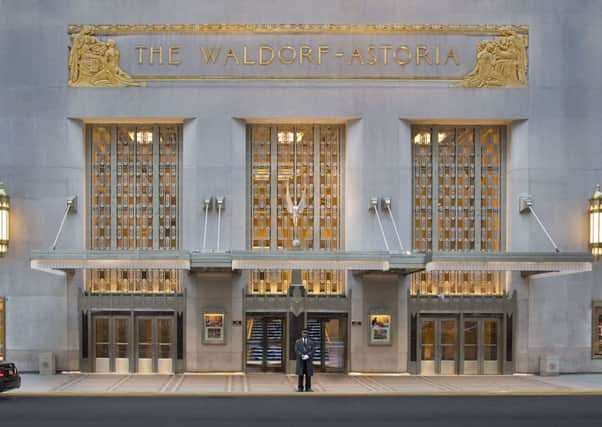Travel: New York, USA


You probably won’t be eligible for the generous discount accorded federal employees on official business. You’ll have to make do without the monogrammed towels and bedding and the bulletproof glass. Nor will a Metro-North train be manned and idling on a siding below Park Avenue to whisk you away in case midtown Manhattan traffic becomes impassable.
Still, you don’t have to be the president of the United States to reserve the presidential suite at the Waldorf Astoria hotel in New York. Last month the three-bedroom, three-bath suite on the 35th floor was booked for Valentine’s Day but still available for the rest of President’s Day weekend at an off-season bargain rate of as little as $4,000 (£2,580) a night. There was a time when prospective guests had to undergo background security checks, and outsiders were barred from even photographing the suite.
Advertisement
Hide AdNowadays, just about anyone who can afford the negotiable rates, which range up to about $8,000 (£5,160) a night, can be ushered into the hotel through the garage, without ever touching the grimy pavement outside, and into the elevator to the Waldorf Towers suite, where every president since Herbert Hoover has stayed.
The Waldorf Towers, which bills itself as a hotel atop a hotel and has its own drive-through entrance on East 50th Street, has 26 “presidential style” suites. The presidential suite itself isn’t even the biggest or the most expensive. (It is surpassed by the Cole Porter, with five bedrooms; the royal, where the Duke and Duchess of Windsor lived; and the penthouse.)
Still, it’s roomy, with a foyer, a living room with a decorative fireplace, a dining room that seats 10, a kitchen and a boudoir off the marble master bathroom. It is spacious enough, at 2,245 square feet, to accommodate 50 guests.
Originally fitted with Colonial-style furnishings, it was redecorated in 1969, “to be evocative of the White House, without trying to copy it,” says Matt Zolbe, the hotel’s director of sales and marketing.
There’s no great original art to speak of, but the living room has an upholstered rocking chair that belonged to John F Kennedy; wall sconces donated by Richard M Nixon; and books by Homer, Shakespeare, Lewis Carroll and JK Rowling (she stayed there). Facing the king-size bed (with 400-thread-count sheets from Anichini) is a desk owned by General Douglas MacArthur, who had a suite at the hotel.
When the Waldorf opened at its current site in 1931, having moved from Fifth Avenue and 33rd Street, Hoover delivered a congratulatory message live on radio from the White House. He moved in 1933 to a suite on the 34th floor, where he lived until his death there in 1964. Eisenhower also lived there (on the seventh floor; his wife, Mamie, was afraid of heights), from 1967 until he died two years later.
Advertisement
Hide AdPresidents rarely stay anywhere else in New York. President Barack Obama overnighted at the InterContinental New York Barclay across the street last May after attending a Democratic fundraising event there, in keeping with the administration’s policy of diversity even in the choice of hotels, but he has stayed at the Waldorf.
While the president and his entourage typically fill three floors of the Waldorf Towers, they don’t pay what you would.
Advertisement
Hide Ad“Someone from Des Moines might say, ‘That’s my mortgage for a month,’ but the president pays less than that,” Zolbe says. “The goal for us is, he’s the magnet that brings in the other delegations.”
When the United Nations General Assembly is in session in the autumn, the hotel can play host to as many as two dozen heads of state simultaneously, he says, “and each can feel that they’re the sun around which everyone orbits.”
The only time they don’t feel that way is when they’re jockeying with 23 other entitled heads of state for an on-call elevator. Nor do they assume a private train will be available to beat midtown traffic, an amenity the president receives for security reasons.
Riding on Metro-North near East 49th Street, you may see what looks like a rusted blue boxcar on a spur directly under the Waldorf. Depending on the telling, it either carried Franklin D Roosevelt’s presidential automobile or is an abandoned maintenance car. The spur is accessible by a freight elevator, which opens onto 49th Street, east of the Waldorf garage.
Roosevelt used the spur, in part to hide his disability (a result of polio) from the public, on at least one occasion. It was 21 October, 1944, when he capped a full day of campaigning with a speech to the Foreign Policy Association. William D Hassett, Roosevelt’s correspondence secretary, later recalled that the spur was built “for the accommodation of the private cars of ‘economic royalists’” and that night it was used “of all persons, by the archfoe of the privileged group for whose delectation this extravagant convenience was devised.”
Even without the special train, to say you slept in the presidential suite places you in a privileged group. For eight decades, history has happened there, and the radio days of big bands and fireside chats resonate for anyone who can afford it.
FACT FILE
Advertisement
Hide AdThe Waldorf Towers, 100 East 50th Street, New York, www.waldorfnewyork.com
© NYT 2015
FOLLOW US
SCOTSMAN TABLET AND MOBILE APPS